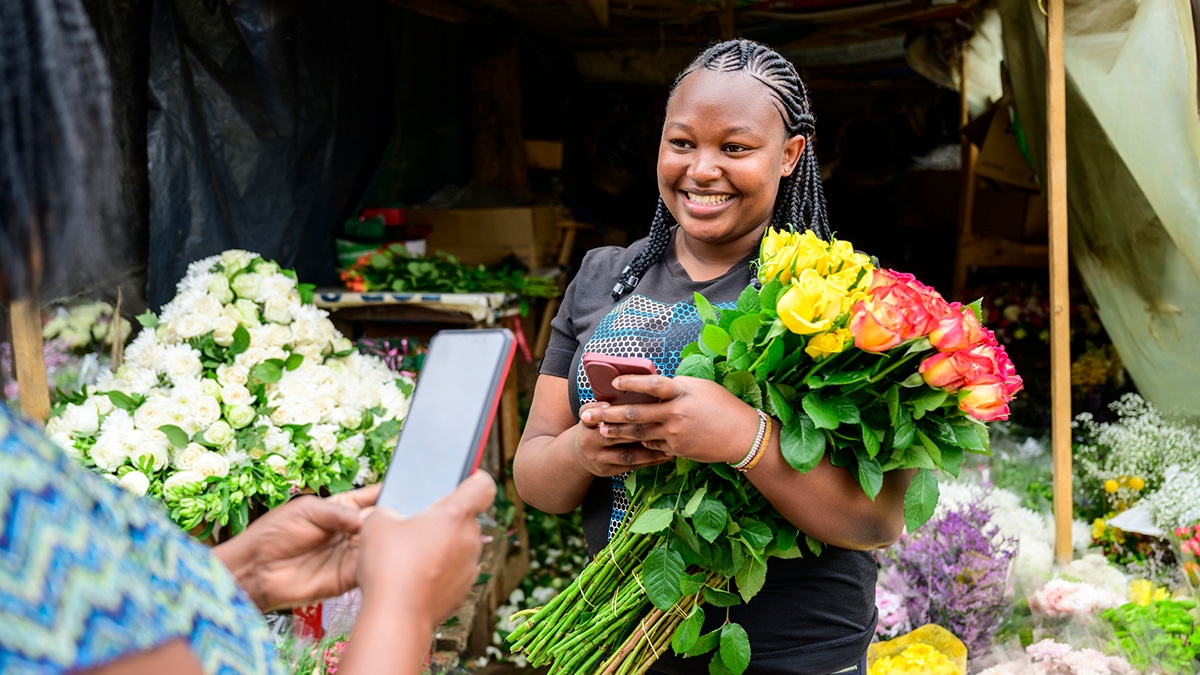In many emerging markets, mobile money has become the most popular method for conducting financial transactions. Africa leads this trend, with mobile money playing a significant role in shaping economies across the continent.
In this article we explore the continued rise of mobile money in Africa, and examine its impact on the region — as well as what the future may hold for this sector.
What is mobile money?
Mobile money as a digital payment system allows consumers and merchants to complete transfers with their phones and make payments for goods and services. This allows those without access to the formal banking system to send and receive money in a safer, more secure way. Through widespread technologies like USSD, the need to visit bank branches or interact with agents has been removed.
Mobile money is now also accessible through Android and iOS apps, however, adoption of those channels largely depends on smartphone adoption in markets where mobile money is on the rise.
Since it first launched back in 2007, mobile money has transformed financial services across emerging markets. According to the 2022 report by the Global System for Mobile Communications Association (GSMA), there are currently 1.35 billion registered mobile money accounts, processing $1 trillion in transactions annually. This equates to almost $2 million per minute of transactions.
Where is mobile money most popular?
Sub-Saharan Africa dominates the mobile money market. In 2021, it was responsible for 70% of all mobile money transactions processed globally. And by the end of 2022, global mobile money transactions are expected to pass $3 billion a day for the first time, with Africa as a driving force behind these estimated figures.
Research suggests that the appetite for mobile money remains strongest in East and West Africa. In Kenya alone, where mobile money first launched, it is estimated that 84% of internet users complete financial transactions using mobile money payments.
However, the GSMA 2022 report also notes that the market in Southern Africa grew the fastest, at 24% year on year. This suggests that the rise of mobile money across Sub-Saharan Africa is not isolated to specific regions. Rather, its popularity is growing across the continent — and shows no signs of slowing down.
Why?
Digital adoption and innovation is powering economic success across Africa. Emerging markets are harnessing the power of modern technology to boost their economies and ‘leapfrog’ traditional stages of development. And, on a continent with an 80% mobile phone penetration rate — and where 65% of the population is less than 35 years old — digital innovation is embraced as the norm.
It’s therefore much easier, secure and more convenient for end consumers across Africa to access financial services — such as paying bills and receiving funds — with mobile money, especially if they live in rural areas or are unable to open a bank account.
However, in recent years, other factors — such as the long-term impact of Covid-19 — have also come into play. National lockdowns and increased hygiene measures – such as not handling cash — have irrevocably changed how many make purchasing decisions. During 2020, the total value of mobile money transactions across Africa was $495 billion, up by 23% compared to 2019. So, although increased access to handheld digital technology across Africa has undoubtedly played a part in the growing popularity of mobile money, Covid-19 has further boosted its adoption.
What’s more, mobile money services meet the day-to-day needs of consumers across Africa in a way that traditional financial services have not. For many end consumers across Africa, mobile money is more convenient, time-efficient, cost-efficient and inclusive than traditional banking systems. There is also a greater degree of trust in mobile money operators than banks within these markets. This is often due to previous negative experiences with the banking system, such as refusal of credit.
What does this mean for service providers, and what does the future hold?
Although mobile money is not a new concept in Africa, recently many regulatory bodies on the continent have announced that they will be broadening the scope and awarding licences to new providers. This represents a greater opportunity for a range of service providers as in the case for Nigeria, where the mobile money landscape has traditionally been dominated by banks and other financial services companies. Telecommunications companies including Airtel and MTN have recently gained their licences to join the mobile money market.
So, what might this all mean for the next phase of growth in the mobile money market?
Currently, mobile money is often used in conjunction with other financial services, such as insurance and loans. An argument could be made that mobile money itself is a platform that aggregates innovative products and services that are developed by third parties.
As mobile technology continues to evolve, so does the scope for what it can do. For example, we can expect the development of increasingly sophisticated mobile money apps which promote an enhanced, streamlined user experience and a more comprehensive suite of integrated financial services and products.
The continued growth of mobile money payments also presents new opportunities as new services and products continue to be added for sectors such as utilities and education across Africa. Pay-as-you-go mobile utility bill payments are a win-win for both the provider and the end user, with increased payment transparency and reduced operational costs.
How Ezra can help
The outlook for mobile money operations in Africa remains strong. However, for some, a lack of inclusive and responsible credit solutions remains a barrier to upward mobility. Without access to essential financial services such as nano loans and small business financing, it becomes increasingly difficult for individuals to participate in the greater economy.
Ezra provides API-based embedded lending solutions to a range of service providers, including banks, mobile network operators, mobile wallets, utility companies and e-commerce platforms, to deliver easy and rapid credit solutions. Our sophisticated yet seamless platform works on all handheld devices, from the most basic feature phones to the latest smartphones.
Ezra understands end consumers in emerging markets. We have built a bespoke credit scoring engine which leverages alternative data to accurately profile millions of customers without a credit history more easily and effectively than ever before. Our models are also rigorously tested and continually fine-tuned, to ensure optimal efficacy and security in our products. We can therefore deliver instant loan decisions to millions of new, previously underserved customers, at little to no risk. The Ezra solution guarantees no capital or operational expense for your business so you can focus on growing your company and increasing profits
We empower these individuals to build their credit score responsibly, in order to increase their access to further lending opportunities in the future. In doing so, we increase reach and opportunity for our partners around the world.
Through its services, Ezra enables mobile network operators and mobile wallets to build effective customer acquisition and retention strategies based on their current needs, while on the other hand it enables financial institutions to enter segments of the consumer and merchant markets that they have been unable to reach thus far. Ezra sets the groundwork for financial inclusion and growth within formal and informal markets.
To learn more about how Ezra can provide embedded lending solutions for mobile money operations.

